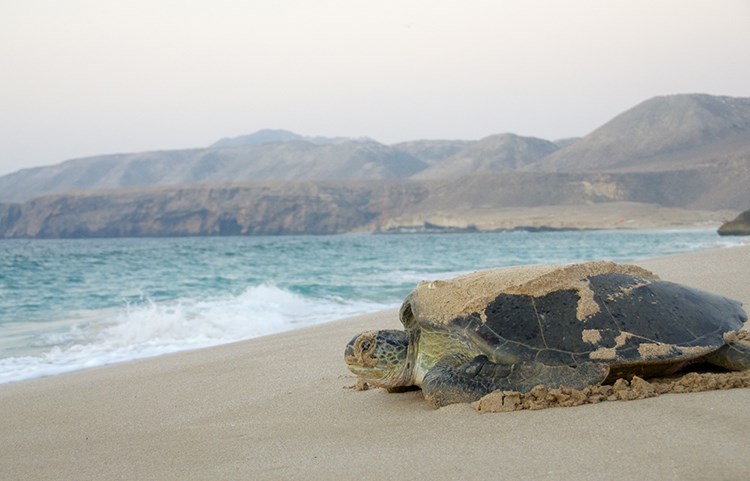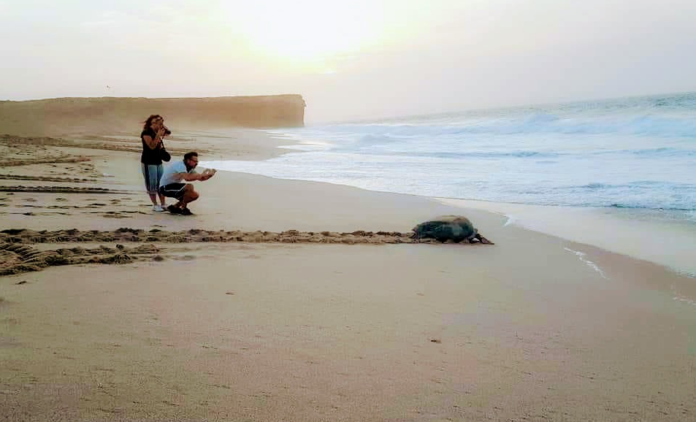Thousands of turtles Journeys protected in the June 20000 green sea turtle nesting beaches in 275 locations in Oman:
Sur Oman: turtles returns every year to lay its eggs on the same beach where it was born decades ago. Ras Al Jins is a quiet sanctuary for turtles where they lay their eggs, securing the continued survival of the species and protecting them from extinction. Apart from the turtle breeding season (which extends throughout the year in varying degrees), you can enjoy the beauty of the beach and view the magnificent tracks left by the turtles.
Jrama and the .. stone
The creek jrama largest and deepest bays in the reserve, which is associated with a narrow corridor to the sea like marine tongue. Penned mud flats up to display kilometers and is bounded on the south coast leads to the swampy land. There is this small creek groups of mangrove trees along the shore eastern and southern Creek, a shallow creek when exposed to drought during the tidal periods in the spring. The creek stone Vistamlh anglers docking station and small boats.
Birds and the effects of trees
Protected contain many physical and biological resources; as there is with sandy beaches and mountain ranges and rocky Gully suitable for gatherings of birds. Scored in protected more than 130 bird migrants and settlers, including: seagulls and terns, and take birds from bodies loam around the creek jrama and Khor stone source feed her, contains Khuran on rallies and coral trees and small mangrove forests Ghaf. And vary the reserve archaeological sites of historical interest, some statistics indicate that there are about 60 main site of the excavations.
Types of protected turtles
Spread in the Sultanate five species of turtles: the green turtle, and Alhurcav, and olive, and Riemannian, and turtle ant that come to the beach in search of food.
Among the months turtles that abound in this region and the green turtle, locally called Balhmsh, and Guillaume, and Houmeh.
The green turtle length of between 75 and 150 cm, and weighs between 75 and 140 kg, and the Harcftan Khtmha in front of her, and consists of a large shield marrow non-overlapping scales similar to the heart without camshafts. The body is flat oval, small and roundish head and ends with a claw prominent, and each party of parties on one paw.
And imbued shield light green color tends to be dark green, and showing other colors such as brown, yellow, and there are spotted and planned, and imbued her body from the bottom in yellow, one of the most widely turtles are found widely in Ras jeans, and along the coast of Ras al Hadd to Al Halaniyat Islands in the Arabian Sea, and in the Daymaniyat islands in the Sea of Oman. And feed these types of turtles at the beginning of her life on the meat, and then become a vegetarian after the first year of life; where they feed on seaweed, according to Encyclopedia remember Oman.
Proliferation throughout the year
Green Turtle multiply throughout the year usually, but the peak of reproduction shall be between June and September in the limit between September and December in Masirah Island head. The females dig their nests in the sands of the beach and lay between 60 and 179 eggs, then reclaimed the pit to return to the sea, and back to the beach again to dig a nest last after almost 12 days.
The period of incubation lasts from two to three months and a half, according to the sands of the beach temperature. The green turtle reaches sexual maturity when she is between 33 and 50 years old and lived until about 100 years ago.
Ras al Hadd and is located east of the city of Tyre, which is part of the turtle nesting beaches set but attracts the largest number of green turtles nesting in Oman, making it of great importance for the continuation of life and the survival of this type of endangered turtles.
Each year it is nesting in this area around 6000 to 13000 turtle, arriving in the Sultanate of other remote regions such as the Persian Gulf, the Red Sea and the shores of Somalia. In addition to the turtles faring this area, the creek grams also features many of the coral reefs scattered beaches.
Vital resources
Marine turtles are considered of the most vital resource reserve, where the Fit thousands of visitors annually to see, as the number of green turtles reached by available estimates about 20 thousand turtle nesting in more than 275 locations along the shores of the Sultanate.
Tour operator
Being organized tours to the protected Ras al Hadd, but according to the guidelines and requirements to ensure the protection and comfort to those turtles are banned visitors to use lights during the visit or take pictures because of light inhibits the nesting female turtles and Arbakha.
Visitors will be distributed to small groups, each of which goes in the direction and by a small lamp Visitors groping their way on the sandy beach where he can be seen large numbers of turtles nesting in a calm not only the sound of waves on the beach splintered broken.
The turtle eggs at night in the summer of this process and are about three batches per season separating each batch and the other two-week period and almost usually turtles will return to the same beach for nesting, which is based on the work of a large hole in the oozing sand dust on distance.
Increasing requests for camping
Increasing day after day camping Ras Alhedd orders in the area in order to enjoy the ambience and exquisite aesthetic is not repeated.
Officials seek to cooperate with the residents of the area and the people to protect the turtles from some activities such as overfishing, and the specter of death for large numbers of which are located inside the prisoner of fishing nets.
The harmful effects of light
Light is one of these harmful factors as the spread in nesting beaches cause harm to marine turtles as a result of what caused the change in behavior, where it turns out that the lighting in the beaches to prevent nesting sea turtles, and nesting lead near the bright beaches to cause serious effects on the young turtles that it’s after they leave the eggs at night on natural light for the beach to move in a natural way straight toward the water, but the beaches that abound where the lights will pay the young turtles to change its destination and are therefore not able to reach the water, leading to higher death rates as a result of being infected by drought or Afterasha.








